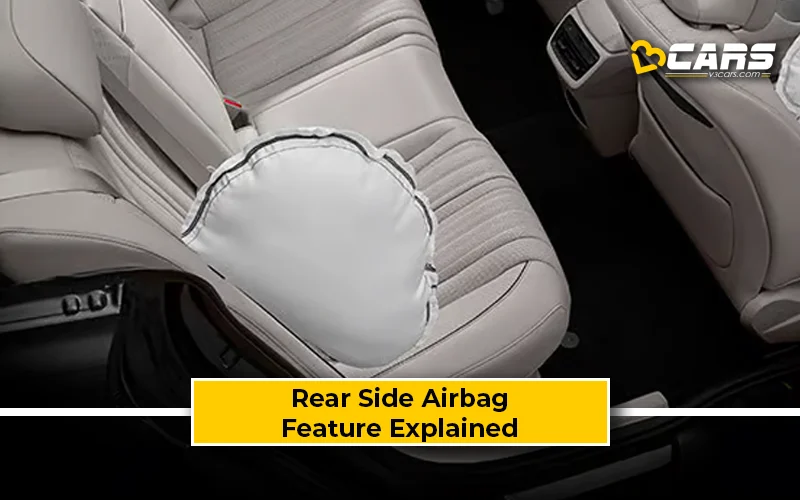Rear Side Airbag – Feature Explained
Rear side airbags are an important advancement in automotive safety, designed to provide additional protection to rear-seat occupants during a side-impact collision. Let’s check out how they work and why they’re significant.

What Are Rear Side Airbags?
Rear side airbags are supplemental inflatable restraint systems installed in cars and SUVs to protect rear-seat passengers in the event of a side collision. These airbags are typically located in the outboard edges of the rear seats.
How Do Rear Side Airbags Work?
The deployment of rear side airbags is a rapid and coordinated process:
- Side Impact Sensors: The vehicle is equipped with sensors, usually integrated into the B-pillars or within the doors themselves, that detect the force and acceleration changes indicative of a side-impact collision.
- Signal Processing: When a side impact is detected, the sensors send a signal to the vehicle’s central airbag control unit.
- Deployment Decision: The airbag control unit evaluates the severity of the crash within milliseconds. If the impact is deemed severe enough, the unit triggers the deployment of the appropriate side airbags.
- Inflation: An inflator, a small canister containing a compressed gas or a pyrotechnic charge, rapidly releases gas (such as argon or nitrogen) into the airbag. This inflation process happens extremely quickly, often in less than 30 milliseconds.
- Cushioning: The airbag expands, creating a protective cushion between the rear-seat passenger and the intruding structure of the vehicle’s side, such as the door panel and window.
- Energy Absorption: The rear side airbag absorbs a portion of the kinetic energy from the impact, reducing the forces transferred to the occupant’s body. It also helps to distribute the impact forces across a wider area of the body.
- Deflation: The airbag begins to deflate immediately after inflation, allowing the occupant to move and preventing potential injury from the airbag itself.
Pros And Cons Of Rear Side Airbags
Here are the pros, or advantages, of rear side airbags:
- Reduced Injury Risk: Significantly decrease the risk of serious injuries to rear-seat passengers in side-impact collisions, particularly to the chest, abdomen, and pelvis.
- Protection for Vulnerable Occupants: Offer enhanced protection for vulnerable occupants, such as children and the elderly, who may be more susceptible to side-impact injuries.
- Complementary Protection: Work in conjunction with other safety systems, such as seatbelts and side curtain airbags, to provide a more comprehensive safety net.
- Increasing Availability: More and more vehicle manufacturers are including rear side airbags as standard or optional equipment.
Here are the cons, or disadvantages, of rear side airbags:
- Added Cost: The inclusion of rear side airbags can increase the overall cost of a vehicle.
- Potential for Inflation Injury: Although rare, there is a slight risk of minor injuries (abrasions or burns) from the airbag’s deployment itself.
- Compatibility with Child Seats: Proper child seat installation and compatibility are crucial to ensure the safe and effective operation of rear side airbags. Care should be taken to follow manufacturer instructions.
Are Rear Side Airbags Worth It?
Yes, rear side airbags are a valuable safety feature. They provide a substantial improvement in side-impact protection for rear-seat passengers, a historically vulnerable area in vehicle collisions. As side-impact collisions can lead to severe injuries, the inclusion of rear side airbags can significantly enhance the safety of a vehicle.
Is It Possible To Install Rear Side Airbags From The Aftermarket?
Installing rear side airbags aftermarket is extremely complex and generally not recommended. Here’s why:
- Complex Integration: It requires extensive modification to the vehicle’s rear seats as well as integration with the ECU and sensors.
- Reliability Concerns: Aftermarket systems may not be as reliable or thoroughly tested as factory-installed airbags.
- Safety Risks: Improper installation can lead to deployment failure, unintended deployment, or other malfunctions, potentially causing serious injury or death.
- Warranty Issues: Modifying a vehicle’s safety systems can void the manufacturer’s warranty.
Note: Check your Car EMI with our - Car Loan EMI Calculator
You can use our Fuel Cost Calculator to see how much any petrol, diesel or CNG car will cost to run based on the latest fuel price in your city.



0 Comments